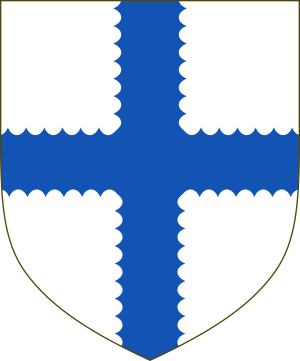John Sinclair, 10th Lord Sinclair facts for kids
Quick facts for kids
John Sinclair
|
|
|---|---|
| Lord Sinclair | |

Lord Sinclair coat of arms
|
|
| Predecessor | Patrick Sinclair, 9th Lord Sinclair |
| Successor | Henry Sinclair, 11th Lord Sinclair |
| Died | 1676 |
| Noble family | Clan Sinclair |
| Father | Patrick Sinclair |
| Mother | Margaret, daughter of John Cockburn of Ormiston |
John Sinclair (who died in 1676) was an important Scottish nobleman. He was known as the 10th Lord Sinclair.
Historians sometimes count the Lords Sinclair differently. Some books, like The Scots Peerage, say he was the 9th Lord Sinclair. They start counting from William Sinclair, who was the 1st Earl of Caithness. However, another historian, Roland Saint-Clair, calls him the 10th Lord Sinclair. This is because he starts counting from Henry II Sinclair, Earl of Orkney, who was the first person officially called Lord Sinclair in public records. For this article, we will refer to him as the 10th Lord Sinclair.
Early Life
John Sinclair was the son of Patrick Sinclair, 9th Lord Sinclair, who was the 9th Lord Sinclair. His mother was Margaret, who was the daughter of John Cockburn of Ormiston.
John Sinclair's Role in the Civil War
John Sinclair, the 10th Lord Sinclair, was a strong supporter of the King during the Civil War. People who supported the King were called Royalists or Cavaliers.
In 1633, he was part of the Parliament meeting held by Charles I of England in Edinburgh. In 1639, he helped lead 1,000 musketeers (soldiers with muskets, a type of gun) from Dalkeith to Edinburgh.
In 1644, he was part of a special committee. This committee was set up to plan for an army to march towards England. He also joined a committee that looked into matters concerning the army in Ireland. Later that year, he was ordered to be paid 20,000 merks, which was a type of Scottish money.
In 1650, a letter from Lord Sinclair was read in Parliament. This letter was written on behalf of the Royalist leader James Graham, 1st Marquess of Montrose. John Sinclair also signed an important agreement called "The Northern Band and Othe Engagement" in 1648.
Imprisonment
In September 1651, John Sinclair was captured at the Battle of Worcester. He was then sent to Windsor Castle and held as a prisoner. He stayed there for many years, until March 1660. He was finally set free by General Monk.
Family Life
John Sinclair married Mary, who was the oldest daughter of John Wemyss, 1st Earl of Wemyss. He gave her a charter, which was a special document that gave her rights to the lands and barony (a large area of land ruled by a baron) of Ravenscraig. Mary was buried at the High Kirk of Glasgow.
They had one daughter named Catherine. She married John Sinclair, who was the eldest son of John Sinclair, Lord Herdmanston. It is not clear if the Sinclair Lords Herdmanston and the Lords Sinclair (from the Sinclair Barons of Roslin) came from the same family line.
Historians have slightly different ideas about when John Sinclair died. James Balfour Paul says he died on November 10, 1674, when he was 64 years old. However, Bernard Burke says he died in 1676, at the age of 66. After his death, his daughter's son, Henry Sinclair, became the 11th Lord Sinclair.
See also

